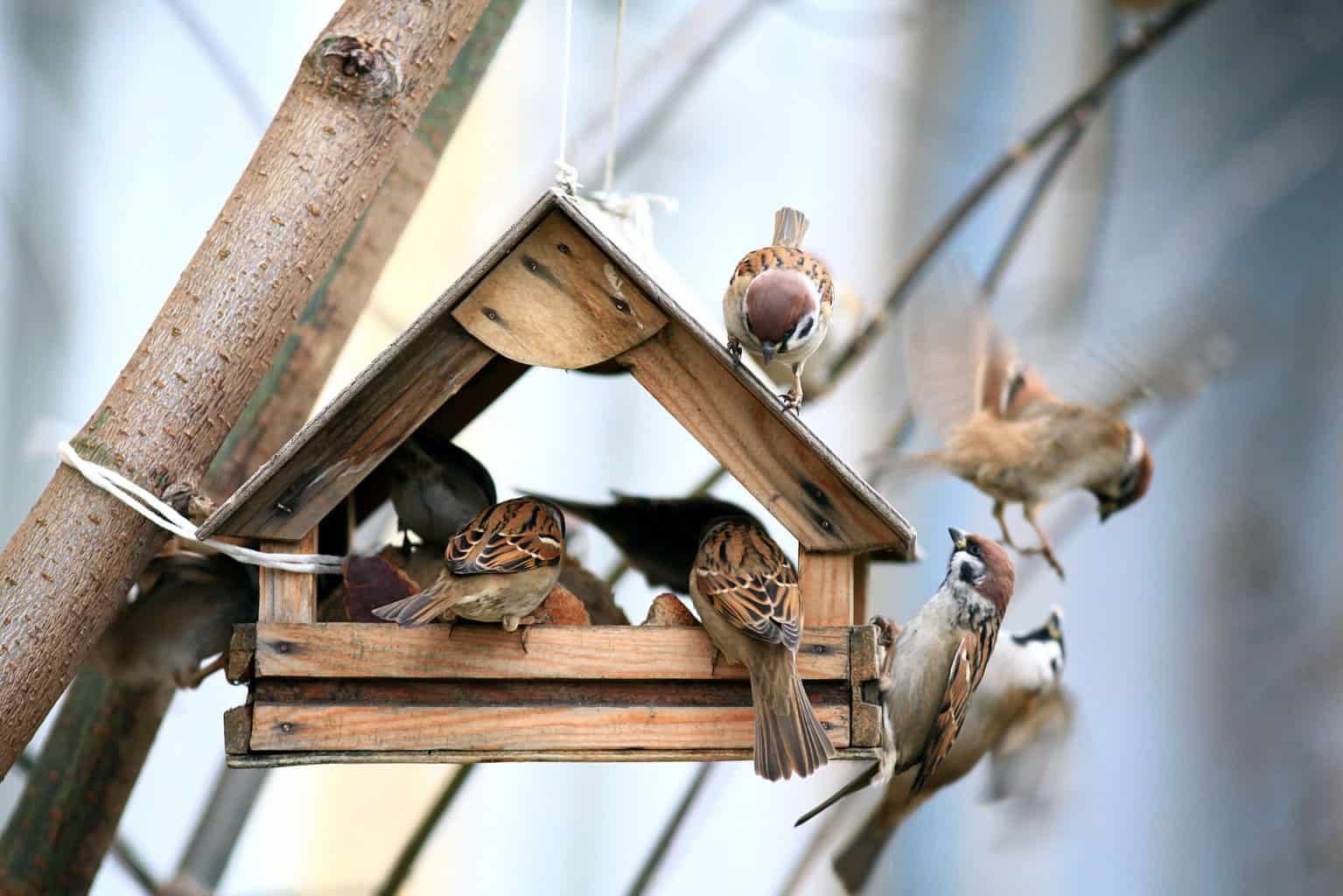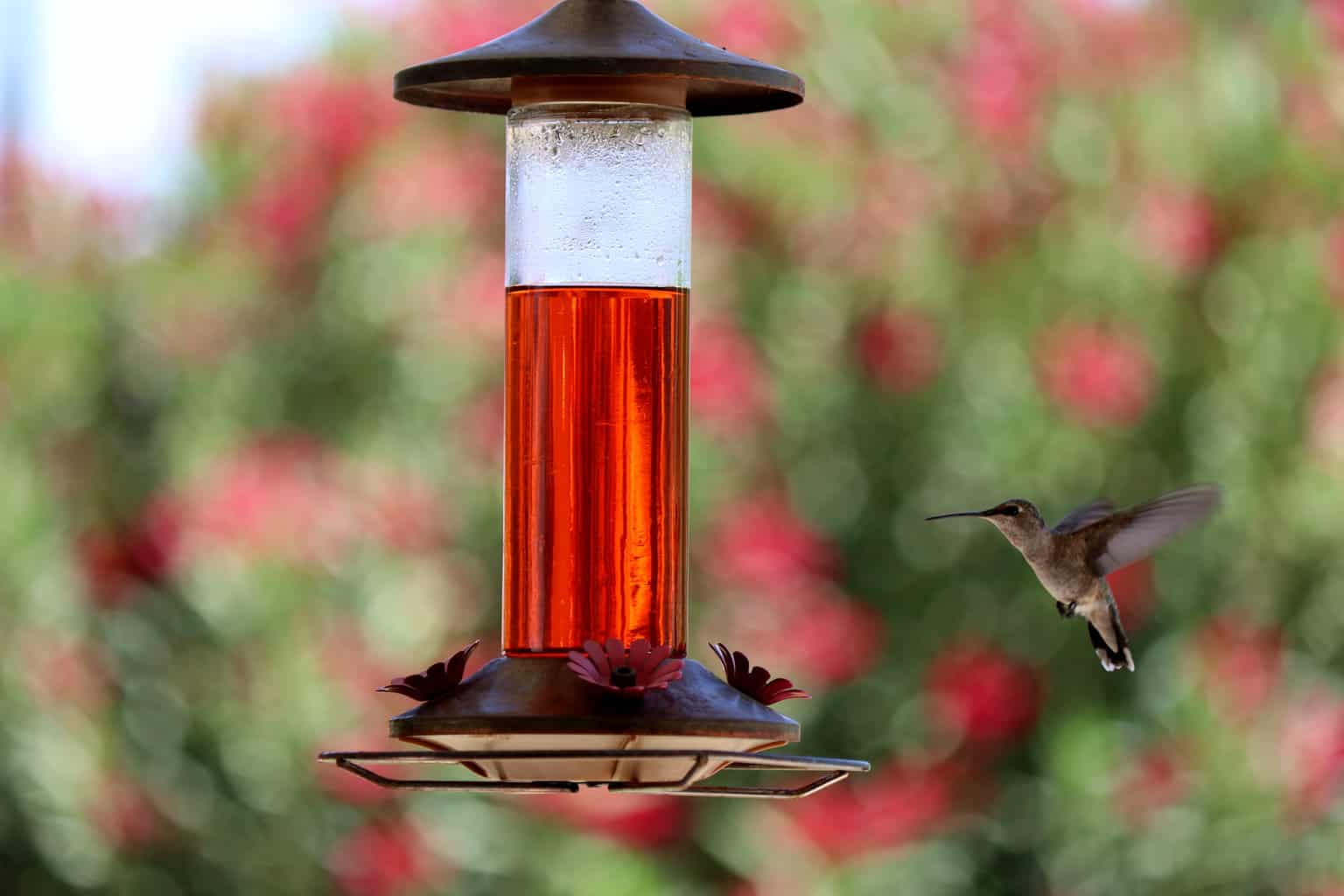The main goal of many bird watchers is to see more birds and to keep them around for as long as possible. One of the top ways to accomplish this goal is by choosing the right bird feeder and bird food combination.
There are lots of types of feeders and many different types of bird food. If you’re looking for a guide to the best bird seeds, click here.
Now, let’s dive into the best bird feeders for every situation.
Tray/Platform Feeders
Keeping it simple to start with, we have tray/platform feeders.
These feeders are large trays that are filled with any type of seed you want. Basic seed mixes like those with black oil sunflower seeds and safflower seeds will be popular with many backyard birds that visit platform feeders.
Cardinals, bluejays, and grosbeaks are some of the many types of birds that may visit platform feeders. These feeders do little to discourage any less desirable bird types like grackles or cowbirds, or even chipmunks or squirrels.

If you want to keep squirrels off your platform feeder, you will need to place it away from trees or bushes that they can jump from, and you may also want to employ a squirrel baffle.
Another potential problem with platform feeders is that they can easily collect moisture and bird droppings, which can build up and ruin bird seed in a hurry.
With this in mind, you’ll want to collect any built-up, uneaten seed every so often to keep things fresh and healthy.
They have their downsides, but, all in all, platform feeders are still a good style of feeder for general bird feeding.
They’re easy to set up and they don’t discriminate against any type of bird species. If you’re not sure what kind of bird you’ll be feeding, consider a platform feeder or the next style of feeder we’ll be discussing.
Hopper/House Feeders
Hopper feeders, also called house feeders, might be the top feeder for entry-level bird feeders.
They are shaped like a house, as their name implies. The seed is introduced into the middle and replenished into a bottom tray as the birds eat it.
They’re good intro feeders, as they’re simple to use and most of them allow pretty much any bird to perch on the bottom platform and eat from them.
For smaller birds like chickadees and nuthatches to larger songbirds like grosbeaks and cardinals, most hoppers are good general feeders.
A few different styles of feeder fit under the house feeder umbrella, but most of them are very easy to fill, clean, and set up.
They’re similar to platform feeders in that the uneaten seed can be a hotspot of bacteria if not regularly cleaned up, although more seed is kept dry than in a simple platform feeder, which is definitely a bonus.
You’ll want to clear up any uneaten seed even more frequently during particularly wet periods of weather, and you’ll also want to include a squirrel baffle of some sort.
Hoppers can be filled with almost any kind of seed, including blends with safflower and sunflower seed bases.
Tube Feeders
Tube feeders are often made from plastic or metal mesh, with perches protruding out from the feeder for birds to stop and eat.
Sometimes these feeders are long and skinny, allowing birds to perch all the way down on anywhere from four feeding ports to as many as twenty. Others are shorter.
The perches of a tube feeder are often short, which excludes some larger birds such as bluejays and cardinals.

They’re ideal for smaller birds like goldfinches, chickadees, and nuthatches, and woodpeckers may visit metal mesh tube feeders as well, as they can grab onto the metal to feed.
Plastic tube feeders are typically inexpensive and make great starter feeders. If you see chickadees or finches of any kind near you, fill a tube feeder with thistle (also called Nyjer) seed and wait for them to show up in their droves.
Other Finch Feeders
Finch feeders are often tube-shaped, but not all the time. Since the most common finch food is a Nyjer seed, a very small seed, these seeds can fit through very small spaces.
Sometimes, this may also include sock feeders, made from cloth mesh with tiny holes in them that finches can pull seed from.
Due to the nature of using a cloth feeder with birds that have sharp beaks and claws, these feeders don’t last forever and will need to be replaced fairly often.
Some people claim that finches prefer them to plastic or metal feeders.
Suet Feeders
Suet cakes, made of animal fat, are a high-energy food that woodpeckers and other birds absolutely love, especially in the winter months when food is scarce.
Wrens, chickadees, titmice, nuthatches, and starlings are among the other birds that also like suet.
Suet feeders can be very simple. Oftentimes, they’re just square metal cages with a hook on top that you place a suet cake inside of.
Some may allow for two suet cakes, and others have a wooden base at the bottom of them. This is a tail prop, which is helpful for large woodpeckers such as pileated woodpeckers when visiting a suet feeder.
Some suet feeders also offer the suet upside down. Birds like woodpeckers and nuthatches have no problem feeding upside down, but some less favorable backyard birds like starlings aren’t comfortable doing so.
There are numerous suet flavors to choose from, including suet with hot peppers mixed in to deter squirrels.
Bluebird Feeders
Bluebirds get their own category of feeder because they eat a different category of food at feeders: mealworms.
Unlike most backyard birds, you won’t typically see a bluebird at your seed feeders. They eat insects, meaning if you want to attract them with food, you’ll need to offer something a little different.
Bluebirds are cavity nesters, meaning they’re anything but claustrophobic. Because of their ability to sneak into small crevices to feed, bluebird feeders often contain small holes for them to crawl through, cages, or domes to keep out squirrels and large birds like grackles or other blackbirds.
Hummingbird Nectar Feeders
Hummingbirds are unlike any other type of bird, so it makes sense that their feeder type is unlike any other as well.
Hummingbirds use their long beaks to drink nectar from flowers. Hummingbird feeders mimic this with small ports that hummingbirds can stick their beaks inside of.

Nectar feeders take two different basic forms. One is a simple bowl-shaped feeder that is filled up with nectar and the other is an upside-down reservoir that fills down into feeding ports below.
The key benefit of a saucer-type feeder is that they’re simple to put together, mount, fill, and clean. However, they must be filled up more often.
Hummingbird nectar is easy to make. Just combine four parts water with one part plain table sugar (no brown sugar, honey, or other sweeteners!) and put it in your feeder, changing it out regularly if it’s not eaten quickly.
Other Feeder Types
While the aforementioned feeder types are the most common ones, the creativity of bird watchers knows no bounds.
Take, for example, a peanut ring feeder. These feeders fill up with peanuts, which birds like bluejays can pull out through the metal rings.
Several feeder styles on this list also come as window feeders, which attach to a window with a suction cup. While this may seem like it would increase window collisions, research has shown it actually decreases the number of bird collisions.
Oriole feeders include stakes to stick a halved orange and a dish for grape jelly, as well.
If you find another type of feeder that doesn’t fit perfectly into one of these categories, it doesn’t mean you won’t be able to attract birds with it.
Much of the fun of birdwatching is about creativity and experimentation. What works for you may be different from what works for other people.
Other Considerations: Material
Now that we’ve talked about the different styles of feeders, let’s talk about how to choose the model.
The most important consideration is material. Some feeders are cheaply made, using materials that don’t hold up to weather, wear and tear from bird’s bills and talons, and rodents such as squirrels.
If you’re looking for an inexpensive feeder, there’s nothing wrong with purchasing one. If you are looking for something that’s going to last for the long haul, consider spending a little bit more money if you have the means to.
Wood vs. Poly-lumber
Many feeders today, especially house feeders, are built with poly-lumber that looks like wood but is a durable, easy-to-clean material. Often, this material comes from recycled bottles and other plastic.
Other feeders are made from actual wood. Wood feeders are natural looking, aesthetically pleasing, and fairly sturdy, but they do come with one downfall.
Unlike plastic or poly-lumber materials, wood is a little more difficult to clean, and over time, moisture from weather and oil from bird seed can start to wear down a feeder.
It is typically a bit more expensive, but if you want a feeder that will last a little longer, you may want to go with poly lumber. Wood may seem more eco-friendly, but if you buy one made from recycled materials, you can be confident you’re doing right by the environment.
Tube Feeders: Plastic vs. Metal
Tube feeders, including thistle feeders, come in plastic or metal mesh.
Metal feeders will withstand the biting of squirrels and the pecking of woodpeckers a bit better than plastic feeders, but plastic feeders can be very inexpensive, making them a popular choice for many bird watchers.
If you’re just getting into bird watching, metal feeders are great, but a plastic feeder for $10 or less is still a good way to get into the hobby.
Additionally, finches and chickadees are some of the most common birds that many birders see across the country, so you’ve got a good chance of seeing birds at a finch feeder.
Or Make Your Own!
You can also make your own feeder with materials you already have. As bird watchers, we are all invested in the health of the planet, and reducing, reusing, and recycling are certainly part of that.

This guide from the National Audubon Society walks you through how to build a feeder from a used milk jug, for example.
Put up Multiple Feeders
While a single tray feeder or hopper-style feeder might appeal to many birds, utilizing multiple feeders is often a good idea.
For example, you might have both goldfinches and cardinals in your yard. Not only will a tube feeder with thistle seed appeal more to the finches, but it will also give these smaller birds a chance to feed without being interrupted by larger bird species.
Even filling up several feeders with the same type of feed can be beneficial for spacing out the visiting birds and appealing to a wide variety of birds.
Frequently Asked Questions
What Type of Bird Feeder Attracts Which Birds?
Some birds will be able to use any feeder, but certain larger songbirds like cardinals, jays, and doves need something with a larger platform to perch on.
Others, such as finches, are on the smaller end of the spectrum and prefer a feeder that excludes larger bully birds like starlings, blackbirds, and jays.
For birds like hummingbirds or bluebirds that eat specialized diets unlike most other backyard birds, you’ll need a different feeder as well.
If you’re seeing certain birds in your yard, do some research about those specific species to see what kind of feeder you need to purchase and what kind of food to put in it.
How Do I Choose a Good Bird Feeder?
Before purchasing a feeder, do some research about what kinds of birds visit the different feeder types. Then, buy a sturdy feeder made with durable materials like poly lumber or metal from a reputable brand.

